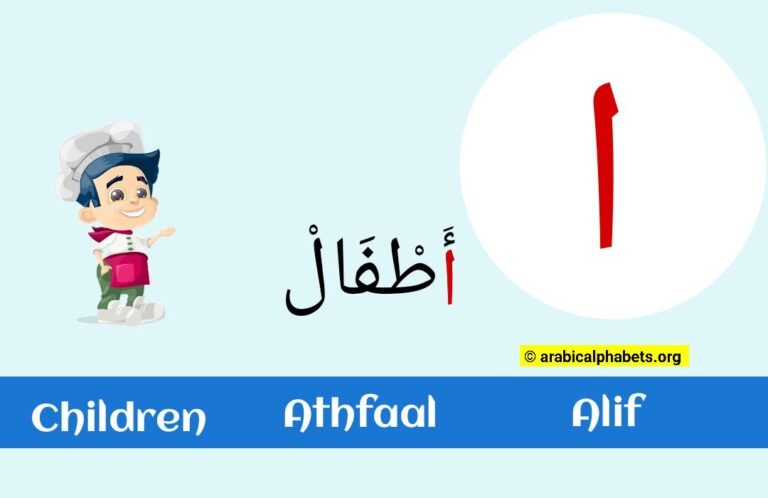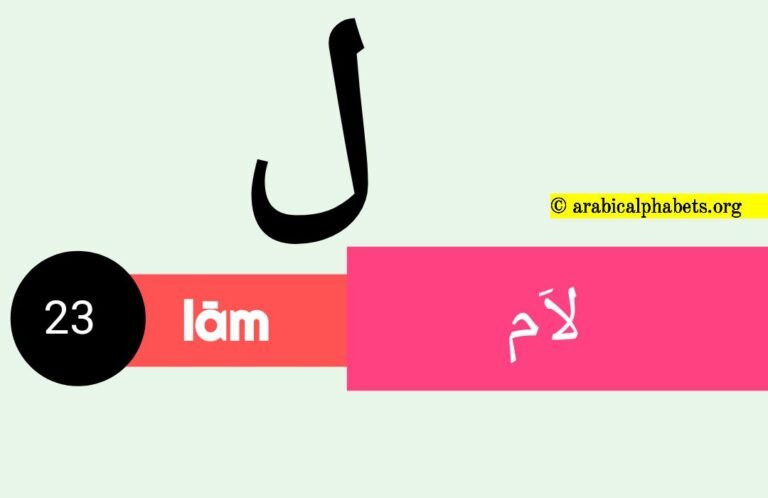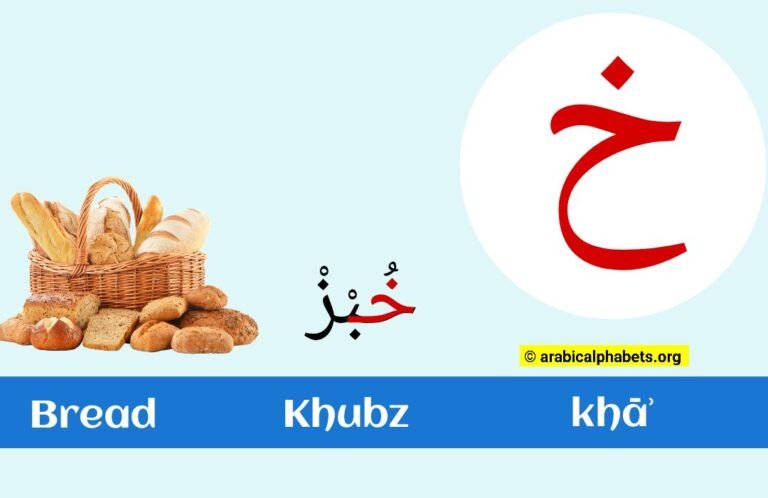Sixth Arabic Alphabet Letter, Get 1 to 28 Arabic Letters Order
When it comes to learning the Arabic language, one of the first challenges is mastering its unique alphabet. With 28 letters in total, each with its own distinct form and pronunciation, getting a grasp on this ancient script can feel overwhelming. However, understanding the order in which these letters are taught can be a helpful starting point.
In this article, we will focus on the sixth letter of the Arabic alphabet and explore how knowing its placement within the larger sequence can aid in learning all 28 letters efficiently and effectively. So let’s dive into the fascinating world of Arabic calligraphy as we unravel the secrets of letter number six!
Sixth Arabic Alphabet Letter Full Details Here
Welcome to an in-depth exploration of the Arabic alphabet letter “Ḥāʾ” (ح). In this guide, we will delve into the pronunciation, form, usage, and cultural significance of this letter in Arabic.
1. Introduction to Ḥāʾ (ح): The letter “Ḥāʾ” is the sixth letter of the Arabic alphabet. It holds a distinctive place in the alphabet and contributes to the rich phonetic diversity of Arabic.
2. Pronunciation: The pronunciation of “Ḥāʾ” is a voiceless pharyngeal fricative sound. To pronounce it, contract your throat while expelling air. This sound is not commonly found in English but can be heard in certain Arabic words.
3. Written Form: The written form of “Ḥāʾ” (ح) features a curved and looped shape, which is distinct from other Arabic letters. In cursive writing, its appearance might vary based on its position within a word.
4. Initial, Medial, and Final Position: “Ḥāʾ” can appear in various positions within Arabic words: initial (beginning), medial (middle), and final (end). Its shape adapts according to its position, contributing to the visual flow of Arabic text.
5. Vocabulary and Usage: Numerous Arabic words start with or contain the letter “Ḥāʾ.” As you learn Arabic, you’ll encounter words like “حلو” (sweet), “حب” (love), and “حديقة” (garden).
6. Grammatical Considerations: Understanding the role of “Ḥāʾ” in Arabic grammar is essential for constructing accurate sentences. It can impact verb conjugations, sentence structure, and pronunciation patterns.
7. Cultural Implications: Each Arabic letter carries cultural and historical significance. Exploring the cultural context of “Ḥāʾ” can provide insights into its use in literature, poetry, and everyday communication.
8. Calligraphic Artistry: Arabic calligraphy is a revered art form, and “Ḥāʾ” presents an opportunity for unique expression in various calligraphic styles.
9. Practice and Recognition: Regularly practice writing “Ḥāʾ” in its isolated form and within words. Enhance your recognition by reading Arabic texts and identifying the letter’s forms.
10. Learning Resources: For a comprehensive grasp of Arabic letters, explore textbooks, online courses, and language apps that focus on phonetics, writing, and grammar.
11. Appreciation of Language: Studying individual Arabic letters, such as “Ḥāʾ,” deepens your appreciation for the complexity and beauty of the language. It’s a step toward both linguistic proficiency and cultural understanding.
By immersing yourself in the intricacies of the Arabic letter “Ḥāʾ,” you’re engaging with a fascinating aspect of language and culture. Keep exploring, practicing, and applying your knowledge as you continue your journey into the world of Arabic.
Table Description -> A – Serial Number, B – Isolated Form, C – Trans-literation, D – Letter name, E – Letter Name In Arabic Script.
| A | B | C | D | E |
|---|---|---|---|---|
| 6 | ح | ḥ | ḥāʾ | حَاء |
Get 1 to 28 Arabic Letters Order
Table Description -> A – Serial Number, B – Isolated Form, C – Trans-literation, D – Letter name, E – Letter Name In Arabic Script.
| A | B | C | D | E |
|---|---|---|---|---|
| 1 | ا | ā | ʾalif | أَلِف |
| 2 | ب | b | bāʾ | بَاء |
| 3 | ت | t | tāʾ | تَاء |
| 4 | ث | th | thāʾ | ثَاء |
| 5 | ج | j | jīm | جِيم |
| 6 | ح | ḥ | ḥāʾ | حَاء |
| 7 | خ | kh | khāʾ | خَاء |
| 8 | د | d | dāl | دَال |
| 9 | ذ | dh | dhāl | ذَال |
| 10 | ر | r | rāʾ | رَاء |
| 11 | ز | z | zāy | زَاي |
| 12 | س | s | sīn | سِين |
| 13 | ش | sh | shīn | شِين |
| 14 | ص | ṣ | ṣād | صَاد |
| 15 | ض | ḍ | ḍād | ضَاد |
| 16 | ط | ṭ | ṭāʾ | طَاء |
| 17 | ظ | ẓ | ẓāʾ | ظَاء |
| 18 | ع | ʿ | ayn | عَيْن |
| 19 | غ | gh | ghayn | غَيْن |
| 20 | ف | f | fāʾ | فَاء |
| 21 | ق | q | qāf | قَاف |
| 22 | ك | k | kāf | كَاف |
| 23 | ل | l | lām | لاَم |
| 24 | م | m | mīm | مِيم |
| 25 | ن | n | nūn | نُون |
| 26 | ه | h | hāʾ | هَاء |
| 27 | و | w | wāw | وَاو |
| 28 | ي | y | yāʾ | يَاء |
Beginner’s Guide to Learning Arabic: Essential Phrases, Vocabulary, and Grammar
Welcome to the exciting world of learning Arabic! This beginner’s guide will provide a comprehensive language overview, equipping you with essential phrases, foundational vocabulary, and an introduction to basic grammar rules.
1. Why Learn Arabic?
Arabic is among the most globally spoken languages, boasting over 300 million native speakers spanning various regions. Learning Arabic opens doors to exploring rich cultures, enhancing travel experiences, and broadening career opportunities.
2. Setting the Stage: Getting Started
Understand the Arabic script and its unique sounds. Begin by familiarizing yourself with the 28 letters of the Arabic alphabet and their different forms.
3. Essential Phrases for Everyday Use
Master common phrases and greetings that will prove invaluable in daily interactions. Learn to introduce yourself, ask for directions, order food, and express basic courtesies.
4. Building Your Vocabulary
Gradually expand your Arabic vocabulary by learning family-related words, numbers, colors, and more. Utilize flashcards, language apps, and thematic lists to reinforce your learning.
5. Basic Arabic Grammar
Understand fundamental grammar concepts, including sentence structure, noun-adjective agreement, verb conjugation, and gender distinctions. While Arabic grammar may differ from English, understanding these rules is essential for effective communication.
6. Navigating Gender and Plurality
Arabic nouns are categorized into masculine and feminine genders. Learn how to apply gender agreements and plurality in your sentences.
7. Constructing Sentences
Combine your growing vocabulary and grammar knowledge to form simple sentences. Practice creating statements, questions, and descriptions to express yourself accurately.
8. Tackling Arabic Script
Continue refining your Arabic script skills. Please pay attention to the various forms of letters when they appear in different positions within words: initial, medial, and final.
9. Listening and Speaking Practice
Engage your listening and speaking skills by exposing yourself to Arabic audio materials. Listen to podcasts, watch videos, and repeat phrases to improve your pronunciation and comprehension.
10. Cultural Sensitivity and Context
Understand that language is intertwined with culture. As you learn Arabic, explore the cultural context that shapes communication norms and etiquette.
11. Resources for Continued Learning
Explore a range of resources, from online courses and language apps to textbooks and language exchange platforms. Tailor your learning journey based on your preferences and goals.
12. Patience and Consistency
Remember that acquiring a new language is a step-by-step journey that unfolds gradually over time. Stay patient, maintain a consistent study routine, and celebrate even the smallest achievements.
13. Cultural Enrichment
As you learn Arabic, take the opportunity to explore Arabic literature, music, films, and traditions. This cultural immersion will enhance your language experience.
Embark on your Arabic learning adventure with enthusiasm and an open mind. Embrace challenges, celebrate progress, and discover a new language and culture. With dedication and practice, you’ll soon find yourself communicating confidently in Arabic.
Conclusion Points
In conclusion, the Arabic alphabet’s 6th letter, “Ḥāʾ” (ح), holds a distinctive place within the linguistic landscape. Its unique pronunciation, distinct form, and role in constructing words and sentences contribute to the beauty and complexity of the Arabic language.
Understanding “Ḥāʾ” enhances your ability to communicate effectively and offers a glimpse into the cultural heritage and artistic expressions of Arabic calligraphy. By exploring this letter and its nuances, you’re mastering a key element of language and immersing yourself in the rich world of Arabic communication and culture.
Certainly, here are ten frequently asked questions (FAQs) about the Arabic alphabet, with a focus on the 6th letter, “Ḥāʾ” (ح):
What is the Arabic alphabet?
The Arabic alphabet is a writing system used to write the Arabic language. It consists of 28 primary letters and some authors include additional characters, like “Ḥāʾ.”
What is “Ḥāʾ” (ح) in the Arabic alphabet?
“Ḥāʾ” (ح) is the 6th letter of the Arabic alphabet. It has a unique pronunciation and distinct form, contributing to Arabic’s phonetic and visual diversity.
How is “Ḥāʾ” (ح) pronounced?
“Ḥāʾ” is a voiceless pharyngeal fricative sound. To pronounce it, contract your throat while expelling air. It’s not a common sound in English but is essential in Arabic.
What is the written form of “Ḥāʾ” (ح)?
“Ḥāʾ” is written in a curved and looped shape. Its appearance varies based on its position within a word: initial, medial, or final.
What role does “Ḥāʾ” play in Arabic words?
“Ḥāʾ” appears in various positions within words, influencing their pronunciation and form. It contributes to the overall visual and auditory rhythm of Arabic text.
Can you provide examples of words containing “Ḥāʾ” (ح)?
Certainly! Words like “حب” (love), “حلو” (sweet), and “حديقة” (garden) include the letter “Ḥāʾ.”
How does understanding “Ḥāʾ” (ح) impact grammar?
Understanding “Ḥāʾ” is crucial for constructing accurate sentences. It influences verb conjugations, sentence structure, and gender agreements.
What is the cultural significance of “Ḥāʾ” (ح)?
Like all Arabic letters, “Ḥāʾ” has historical and cultural importance. Exploring its cultural context enhances your understanding of its use in literature, poetry, and communication.
Can you explain the connection between “Ḥāʾ” (ح) and calligraphy?
“Ḥāʾ” is stylized differently in various calligraphic styles, making it a popular choice for artistic expression in Arabic calligraphy.
How can I practice and learn more about “Ḥāʾ” (ح)?
Practice writing “Ḥāʾ” in different forms, explore its usage in words and continue your journey by utilizing resources like online courses, textbooks, and language apps.






